By Amanda Drane
July 18th, 2023
Lake Boehmer shimmered in the West Texas sun, a 60-acre body of water in Pecos County growing by roughly 200 toxic gallons a minute.
The dry desert air around Boehmer carried salt and the stench of rotten eggs, a hallmark of poisonous hydrogen sulfide. Sulfur and salt crystals coated the withered remains of mesquite killed by water about three times saltier than the ocean.
More dangerous is what you can’t see, feel or smell at Lake Boehmer — the subsiding earth, the radioactivity in the water, the methane in the air.
The high-pitched whine of an alarm pierced through the stench, indicating hazardous levels of hydrogen sulfide. Hawk Dunlap, a well control specialist tasked with monitoring the gushing problem at a nearby ranch, ushered observers to safer ground. “Come on,” Dunlap said. “The wind’s dying. Let’s get out of here.”
The headwater of Lake Boehmer is a wildcat well drilled generations ago and passed along, in 1951, to then-landowner William B. Neely for use as a water well. It sprang to life in the early 2000s, belching out water that no one asked for. The lake of oil field waste has been growing for 20 years.
Boehmer, named after another former landowner, has become a poster child for what can happen when no one takes responsibility for an old well. It provides a pathway for toxic waters flowing underground to rise to the surface.
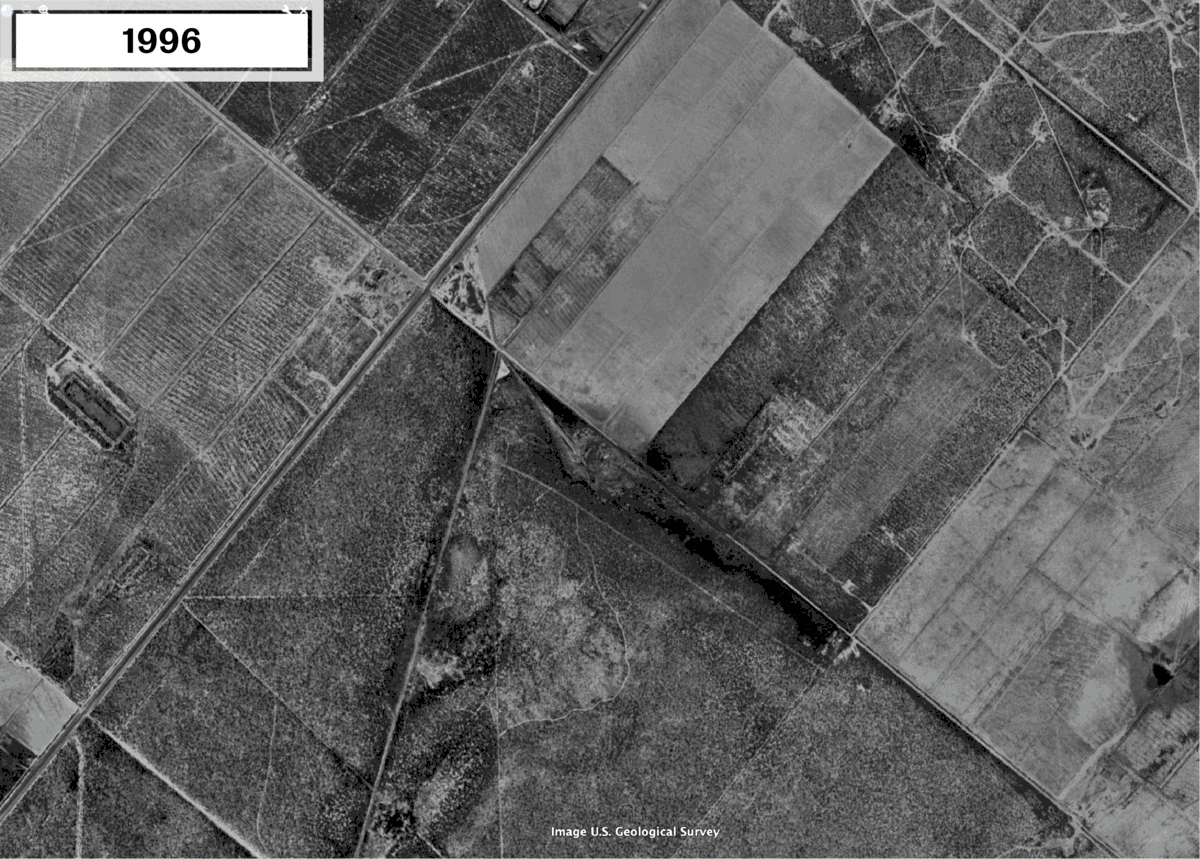
Pressure forces flows onward, heedless of property lines as they search for an outlet. In this way, water and pressure are combining to expose previously undiscovered holes, leaks and cracks that may allow toxic waters to run amok underground. Geysers, gushers and road-swallowing sinkholes are signs at the surface that something is festering underground.
In some cases, operators are injecting wastewater into old oil fields that have problems no one realized until recently. Without warning, the wastewater can return to the surface through orphaned wells that were never documented or plugged wells that are failing, according to new research by Laura Capper, director of the Produced Water Society and principal of the consulting firm EnergyMakers Advisory Group, which is studying the relationship between pressure and aging subsurface infrastructure.
It’s a problem that has been unfolding for generations, she said, citing records from the 1940s in which operators reported water they were injecting underground was going missing. Salty wastewater flowing underground could have sped the deterioration of cement and steel needed to protect aquifers and seal off formations from each other.
“We didn’t used to think water going anywhere was bad. You know, they just probably thought, ‘Oh, good. It’s not my headache. I’m getting rid of my water.’ They didn’t think about where it’s ending up,” she said. “The good news is I think people are generally figuring this out.”
She said it’s hard to blame today’s operators and regulators who until now did not know how deteriorated some subsurface conditions had become. “I think it’s far greater forces that have been evolving for a long, long time.”
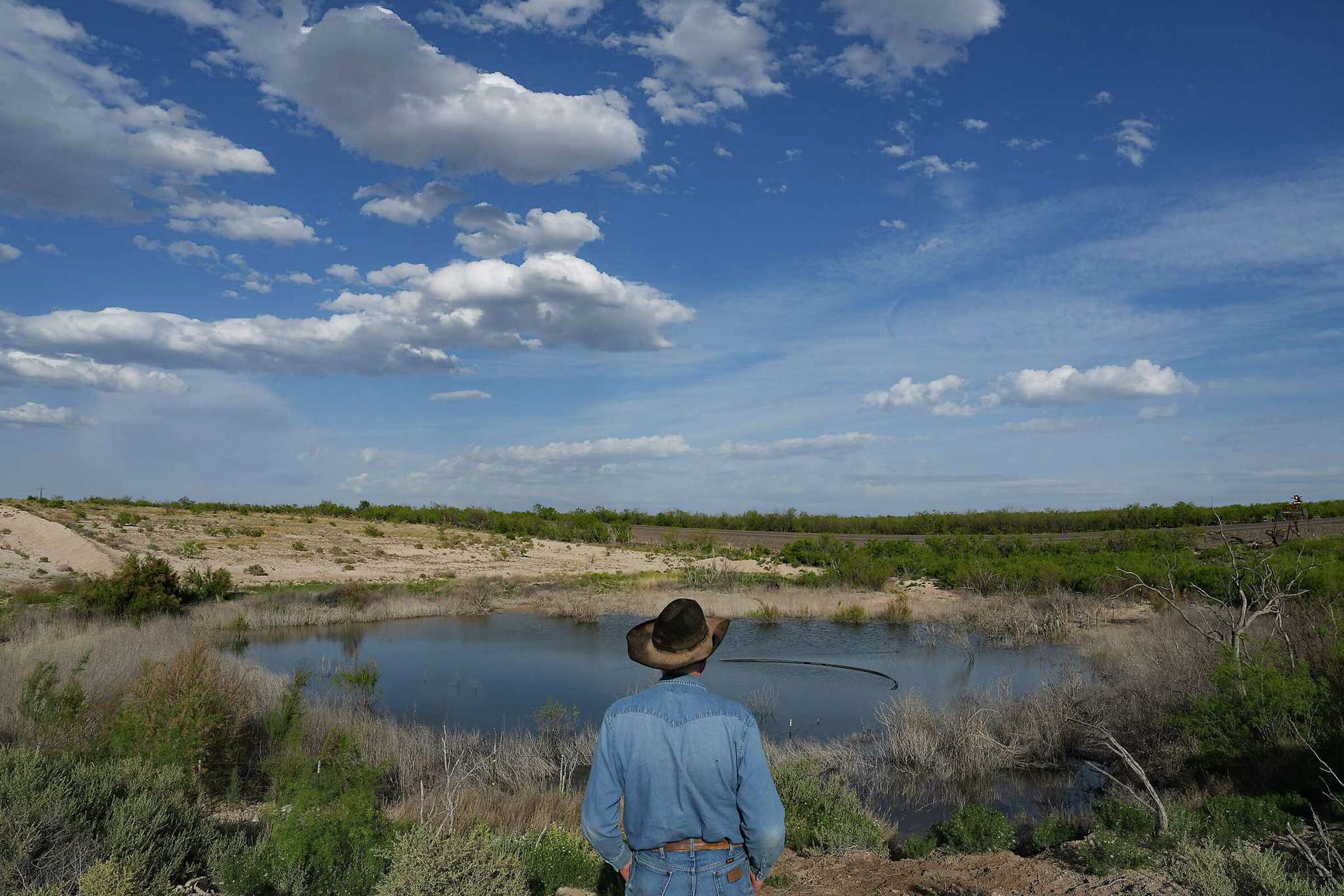
Rancher Schuyler Wight looks over a sinkhole near Highway 1053 Wednesday, April 26, 2023 in Imperial. The sinkhole happened following TxDOT filling in a well near the roadway.
Elizabeth Conley/Staff photographer
For those working in the field, issues with salty water migrating through mysterious channels underground and into unplugged wells have become easy to spot, said Kurt Knewitz, who brokers saltwater disposal wells. Knewitz said he has backed away from the business after seeing the phenomenon firsthand and worrying about the broader implications for the industry.
The problem not only threatens Knewitz’s disposal business, which manages wastewater from oil and gas producers, but also groundwater resources in drought-prone West Texas as well as the larger oil and gas industry.
“It’s a matter of time before some of these become very serious, significant issues,” he said. “There’s a threat to the entire industry, really, especially with (the Biden) administration. They could start imposing new regulations that could be extremely restrictive for us to be able to operate in the state.”
Knewitz said he has been trying to raise the alarm in his circles, but it’s not a topic that people want to talk about. “They want to ignore it because it takes money and time and resources.”
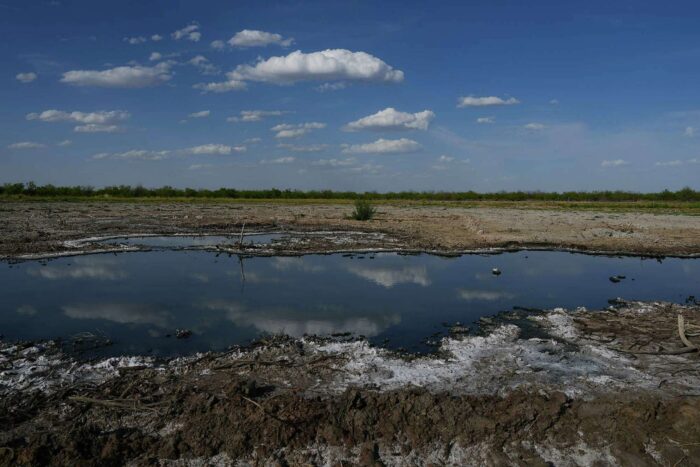
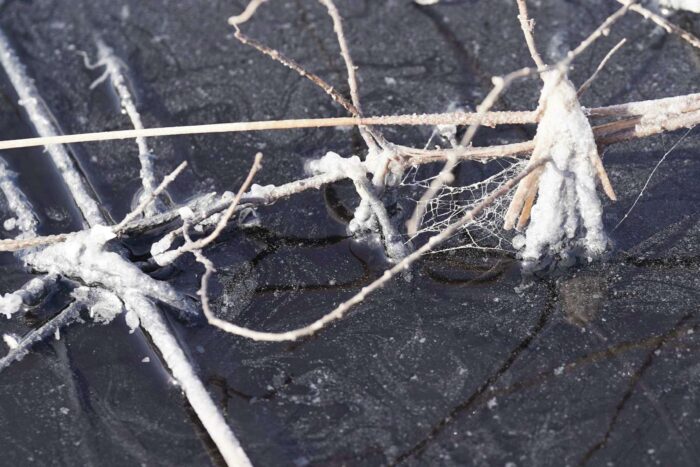
While operators and regulators might prefer to address this problem quietly, Antina Ranch owner Ashley Watt shouts about it from the rooftops. Watt, a Houston energy entrepreneur who inherited her family’s property, has dug in her heels and spent millions of dollars investigating and drawing attention to what she believes could be “the biggest contamination story in human history.”
It didn’t start out that way, she said. After the first well on her property, Estes 24, started spewing toxic water in June 2021, she said she approached Chevron. The supermajor acquired some of the old wells at her 22,000-acre ranch in Crane County when it bought Gulf Oil in 1984. Her request was polite but firm: “Clean up the ranch.”
“What I didn’t realize is cleaning this up is their worst nightmare because if the precedent is they have to clean up this mess each time,” she said, “they’re bankrupt.”
Chevron said in a statement that it is trying to work with Watt, and blamed her for delays to the process.
“We have continuously tried to address concerns raised by Ashley Watt about her Antina Ranch property,” it said. “Over the course of the past two years, she has denied or slowed access to Chevron experts.”
Ashley Watt, owner of Antina Ranch near Monahans in West Texas, stands outside Chevron headquarters in downtown Houston on Tuesday, May 2, 2023.
Elizabeth Conley/Staff photographer

The issue of underground water spewing from uncapped or insufficiently capped wells is coming to a head. Fracking a well requires a massive amount of water and it releases even more water trapped in sedimentary rock, which comes back to the surface as unpotable wastewater. Most of that water gets reinjected underground for disposal under high pressure in old oil wells.
Regulators in Texas and New Mexico began limiting where operators could put their wastewater after they blamed deep injections for a rash of earthquakes in the region in 2021. The desperate hunt for disposal wells forced operators to inject it into shallower spaces which, in some areas, caused pressure to build in shallow reservoirs that are closer to protected groundwater resources.
“You think you’re fixing an earthquake and you may put something closer to an aquifer than you should,” EnergyMakers Advisory Group’s Capper said. “We’ve been in a lot of conversations lately with operators.”
Lorie Sanders didn’t even know she had old wells on her 40-acre property outside Abilene until dirty water started springing from one of them in February. The Railroad Commission was notified. A few weeks later, she said, it showed up and started digging up trees and installing trenches to hold the salty water. Another well sprung a leak, as did wells on her neighbors’ properties, she said.
The damage done to her property is irreversible, Sanders said, yet it seems there is no one taking responsibility. “I feel like somebody’s being protected and it’s not me.”
A dried riverbed where the Pecos River flows on Wednesday, April 26, 2023 in West Texas.
Elizabeth Conley/Staff photographer
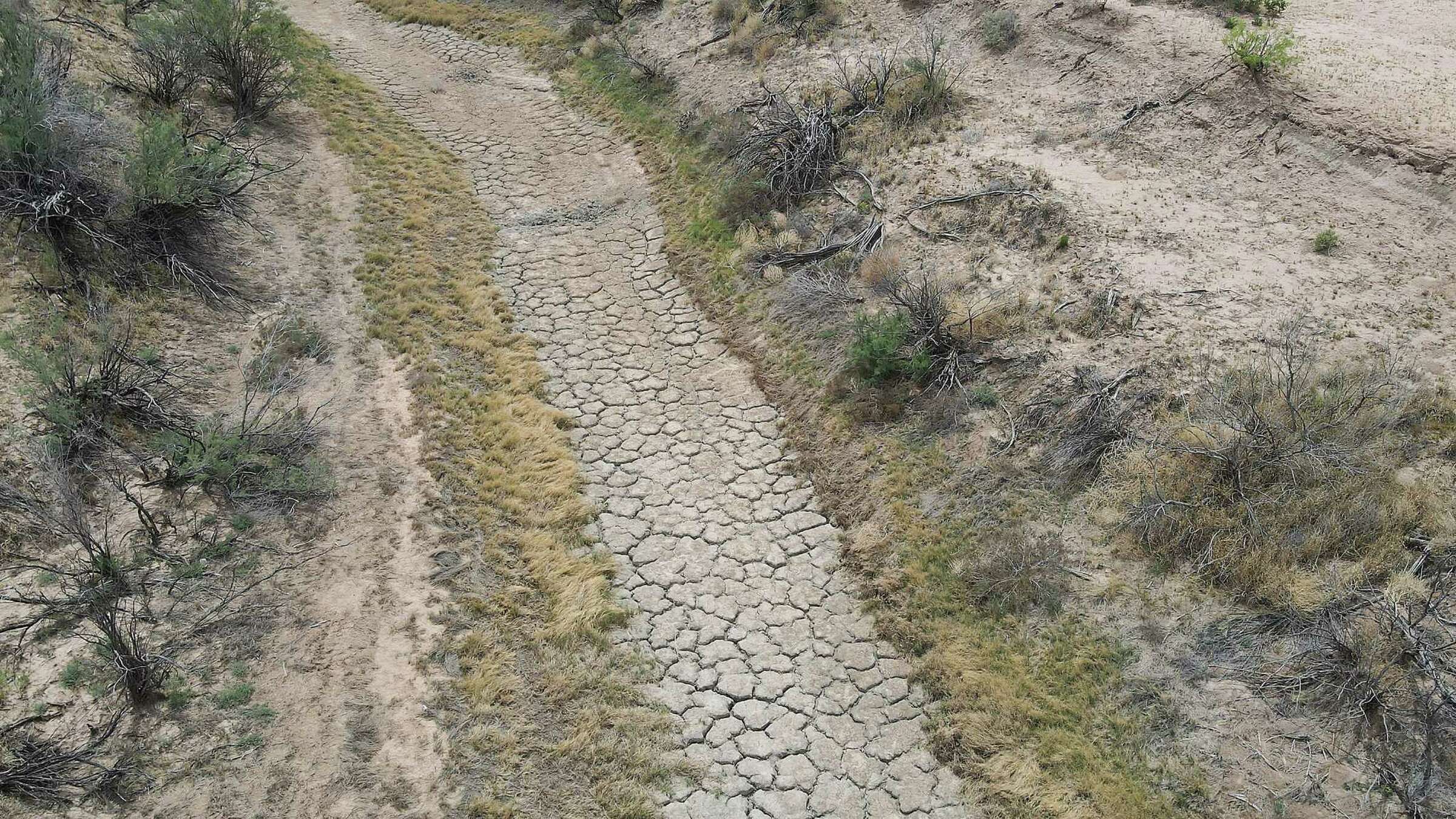
A traveling nurse, Sanders is familiar with consequences. She doesn’t understand why oil and gas operators don’t appear to face any for their actions, even if unintentional.
“I’m a nurse. If I didn’t follow through and I killed a patient, what would happen to me?” she asked. “I would go to prison.”
Accountability in these matters can be trickier than it seems, said Robert Traylor, a retired geologist who worked with the Railroad Commission for 25 years. “It gets complicated to figure out what the hell is going on,” he said. “The well that is spewing water may not be the one that is causing the problems. It’s a medusa. The more you try to look at it, the more complicated and messy it gets.”
In the case of Lake Boehmer, decades of finger-pointing over who should be held accountable has let the filthy lake fester and grow. The Railroad Commission says it is a water well — not an oil well — so it falls outside its jurisdiction. But the Middle Pecos Groundwater Conservation District argues the well was drilled for oil and oil field waste is what gurgles from it. The district blames nearby oil and gas operators intentionally pressuring up their fields so they can extract more crude. The local groundwater district is pursuing the matter through a formal hearings process in an attempt to convince the commission to take responsibility.
“The combination of abandoned wells that are unplugged or need to be re-plugged, together with nearby enhanced recovery operations, is causing rampant subsidence and the degradation of groundwater and surface water quality,” the groundwater district wrote in its complaint, citing groundwater sampling that found radioactive compounds, methane and hydrogen sulfide.
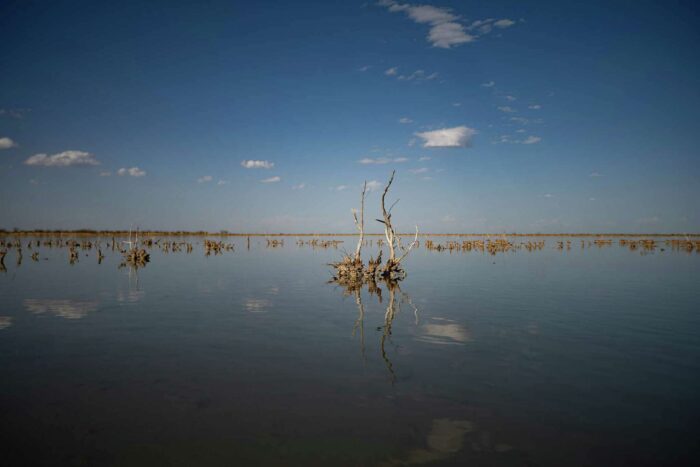
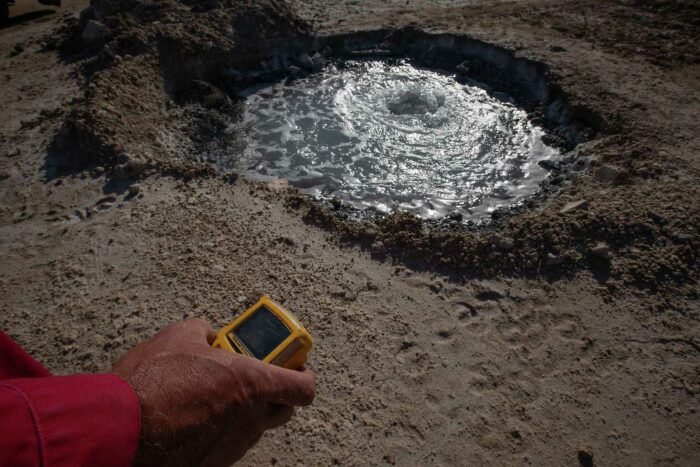
The district lobbied the Legislature, which in its latest session approved a $10 million grant to plug old water wells in Pecos County. The water district plans to continue its appeal with the Railroad Commission.
Underground injections of dirty water and other chemicals also threaten the future of underground aquifers that, decades down the road, could be crucial to survival in drought-prone West Texas, said Virginia Palacios, executive director of Commission Shift, a nonprofit advocating for more-stringent oil and gas regulation.
“It turns into this situation where you end up having to manually clean all old water before it’s available for human use,” she said, “and that gets very expensive.”
Solutions won’t be easy, Traylor, the geologist, said. These problems have been brewing since the first oil wells were drilled in the 1800s.
“We were more interested in making money. We didn’t know to think of all the bad things that could have happened,” he said. “We just went ahead, closed our eyes and carried on. Now we’re having all these problems comin’ to bite us.”
Uncontrolled water flowing beneath old wells also is a recipe for sinkholes. The unplugged or poorly plugged wells can act as a pathway for water to travel into other formations, including layers of salt and limestone that are easily washed away. Without the layer of salt propping up Texas soil, the earth caves in.
That’s what appears to be happening with a well around the corner from Lake Boehmer that is buckling a stretch of FM 1053, a two-lane road connecting Imperial with Fort Stockton. State agencies, which tried once to cap the well, have thrown up their hands and decided it would be easier to move the highway than fix the sinkhole.
The Texas Department of Transportation said it plans to spend $30 million moving the road “due to the continued growth of the subsidence zone.”
Schuyler Wight, who owns a ranch neighboring the sinkhole, said he fears the same will happen with one well on his property recently plugged by the Railroad Commission. He said the casing had collapsed and the crew couldn’t find bottom. The Railroad Commission argues the plug job was done successfully, noting “decades of expertise in this area.” It is not always safe or advisable to seal all the way to the bottom, it said, lest the plugging itself cause the well to collapse.
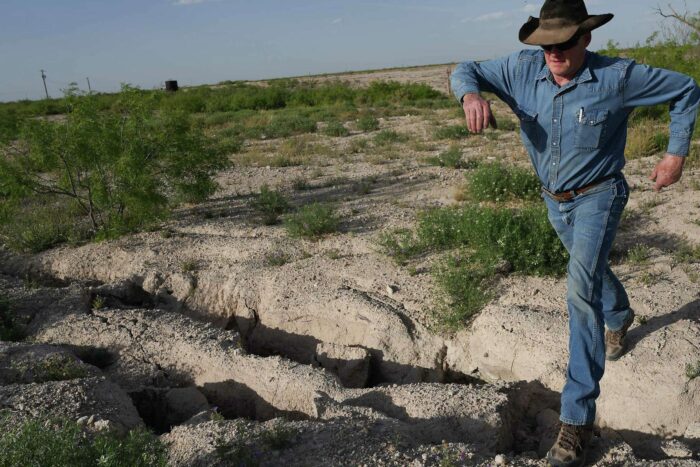

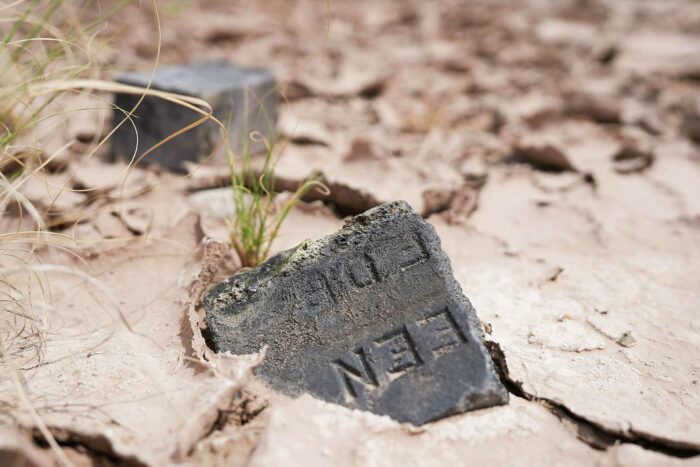

“If they were to do more than that, it would collapse,” a spokeswoman said. “They fill it as much as the engineers say is safe.”
Standing on the dry, cracked bed of the Pecos River, Wight looked up at a once-underwater wellbore, riddled with large, rusty holes. Wight estimates the undocumented well is nearly 100 years old. It offers a window into what the other wells might look like underground, he said — rife with holes that allow dirty water to go where it shouldn’t. “This is going to cost a boatload of money,” he said.
When the river was flowing, he could run cattle and the water would act as a natural barrier. Elsewhere on the property, cow tracks were visible in the mud where oil and water spilled from old wells. He said the cows are drawn to the salt, so they often lap up the toxic fluids flowing from the neglected wells. “Do you wanna eat beef that’s licking off this stuff?”
He knew there were old oil wells on the property when he started buying parcels in the 1980s, he said, but he didn’t realize they would get this bad before someone plugged them. “It’s severely limited what I can do with the property.”

Gas and salty water bubbles out of a well on Lake Boehmer on Tuesday, April 25, 2023 near Imperial.
Elizabeth Conley/Staff photographer
This story is the second in a three-part series. Read Part 1 here.